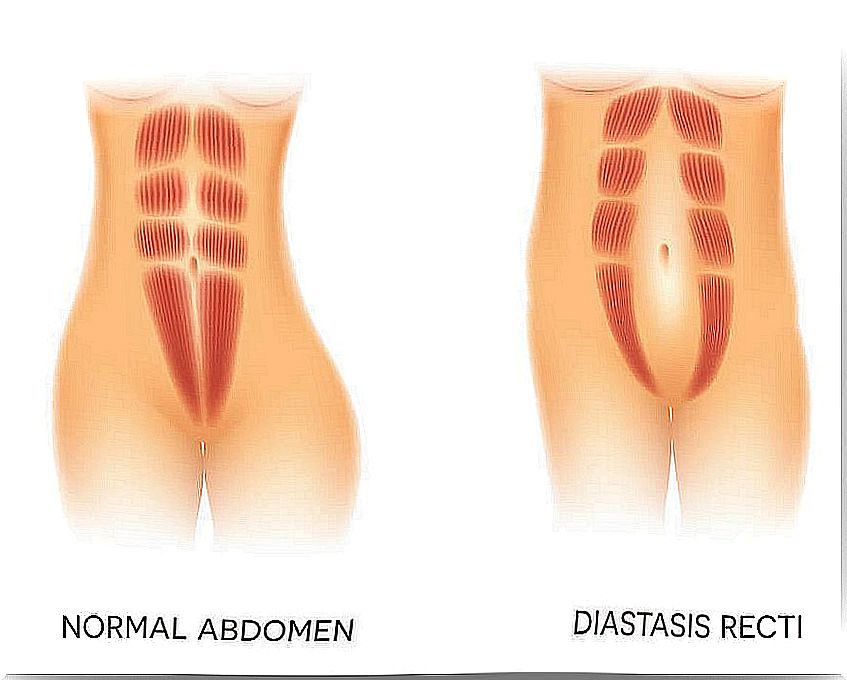Abdominal Diastasis: What Is It And How Is It Treated
Have you given birth in the last few months or have you had abdominal surgery? If you have noticed a separation or bulge in your belly, you may have a diastasis rectus abdominis. Don’t worry, it can be recovered!
What is diastasis rectus abdominis?
The diastasis of the rectus abdominis muscles is the result of the separation of these two muscles from each other. Specifically, the muscles located on the outside of the abdominal wall. Yes, those that you associate with the desired chocolate bar.
Under normal conditions, these muscles are joined by a central line, the linea alba, which runs from the thorax to the pubis. After certain traumatic conditions, this linea alba can deteriorate, weaken and stop doing its job. This causes the muscles to separate.

In the most severe cases, diastasis can be seen with the naked eye, as a bulge or sag in the center of the abdomen. It is a problem that must be treated, not only because of its physical impact on an aesthetic level, but because it can be the symptom of a greater problem.
Among other functions, the rectus abdominis muscles are part of the abdominal wall. Therefore, they help regulate intra-abdominal pressure and compress the thoracic viscera. Without good functionality on your part, symptoms such as low back pain or pelvic floor dysfunction may appear.
What Causes Abdominal Diastasis?
The two main causes are pregnancy and abdominal surgery. Natural abdominal stretching during pregnancy is normal and expected. Every woman will have some level of diastasis recti in the third trimester. It is a necessary process that allows the baby to grow progressively.
For many women, the abdominal gap remains widened at 8 weeks and, if left untreated, it can remain even after a year of delivery.
Two out of three mothers with diastasis recti also have some level of pelvic floor dysfunction. And the problems related to it, remain and increase over the years. Don’t put it off, treat it.
But this is not exclusive to women… Men can also suffer from diastasis recti! Abdominal surgery, poor weight lifting mechanics, or increased body weight are risk factors for developing an abdominal diastasis.
How do I know if I have abdominal diastasis?
The best way to confirm a diagnosis of abdominal diastasis is by consulting your doctor or physical therapist. However, to raise suspicions, first you can follow some indications that can help to detect the problem.

Instructions
- First, lie down on the bed and lift your head, staring at your abdomen.
- Do you notice a lump in the middle of your belly?
- Next, if you put your fingers below the navel and following a line towards the pubis …
- Are the fingers sinking or is the abdominal tissue firm?
- In the same position, try coughing.
- Does the abdomen remain tight, does it even descend or do you see that the abdominal mass comes out a lot?
If during the test a bulge appears, your fingers sink in, or when you cough the abdomen comes out, it is a sign that you may have a diastasis rectum. Therefore, your abdominal pressures are not balanced.
How to treat diastasis rectum?
Although the development of a diastasis rectum cannot always be prevented, there are ways to solve it and thus avoid further damage. Abdominal diastasis is treated with an integrated program designed to align, connect, and strengthen the entire body core.
Several things must be taken into account during treatment, such as breathing, posture, body control, and pelvic floor work.
Impact exercises such as running, aerobics or performing traditional sit-ups flexing the trunk, are not recommended. They increase abdominal pressures and further stress the pelvic floor muscles.

The general recommendation is to go to a health professional to ensure the correct application of the treatment. After a medical evaluation, you can begin a personalized treatment.
Your therapist will use a series of exercises from different disciplines. They could well be hypopressive exercises, breathing exercises, pelvic floor activation, among others.
The idea is that you regain your figure and avoid any complications associated with diastasis. In addition, by the way, they can help you improve your body awareness and create habits related to your posture and the way you move.









